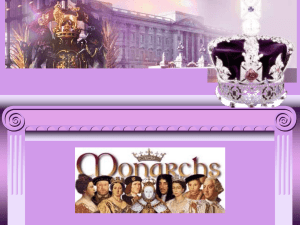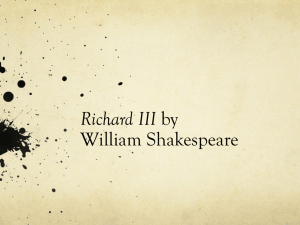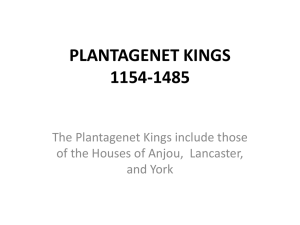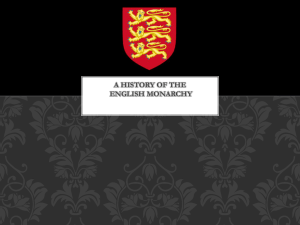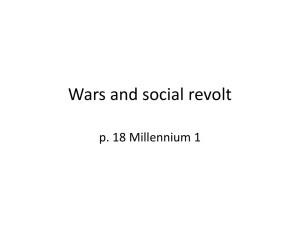English Royal Family. War of The Roses.
advertisement
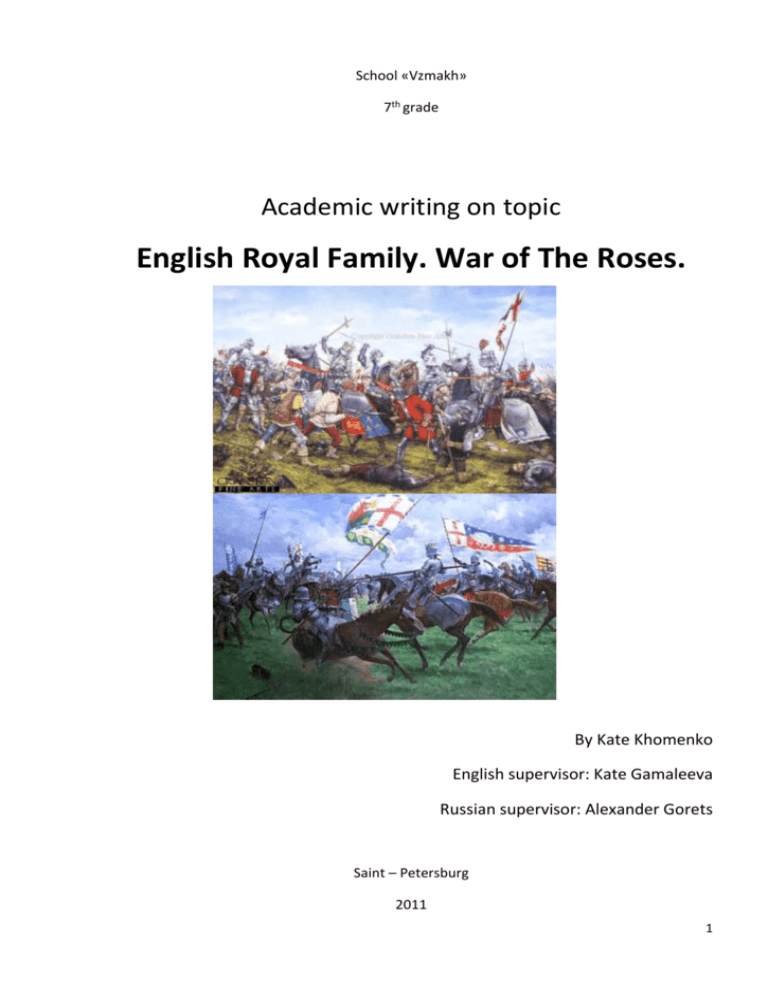
School «Vzmakh» 7th grade Academic writing on topic English Royal Family. War of The Roses. By Kate Khomenko English supervisor: Kate Gamaleeva Russian supervisor: Alexander Gorets Saint – Petersburg 2011 1 Contents Introduction ………………………………………………….. 3 Chapter 1………………………………………………………4 Chapter 2………………………………………………………6 Chapter 3………………………………………………………8 Conclusion………………………………………...………….11 Appendix………………………………………………..……12 Sources…………………………………..…………………...14 2 Introduction. My topic is English Royal Family - War of the Roses. I have chosen this theme because I`m interested in English history and I want to know more about English Royal Family. Also I think we should learn the history because all people mustn`t forget the events of the past for not to repeat those errors. So I have tried to combine my interests with topic of the session. I have already read some books about medieval Britain and I was fond of them. I thought that The War Of The Roses is the most interesting event in the Middle Ages of Britain. So I wanted to know something more about reasons of the war started and the changes after the war of Red and White Rose. My work is divided into 3 parts: in the first part I`d like to tell about the main situation in England of that time, in the second part I will analyze some reasons of the war started. In the third part I`m going to explore the changes happened after the War of Roses. As I decided the aim of my academic writing is to explore the changes happened after the war finished… 3 Chapter 1. 1.1 - England in 15th century. England is a big country and there are many different regions with different leaders. For many centuries there were feudal wars. The 15th century is not an exception. In that time in Britain there were two main generic groups: York and Lancastrian Houses. They were fighting to each other for the throne. The 15 century in England was very troubled. There were many wars, not only domestically but also with its neighbors: 1415: Battle of Agincourt fought between the Kingdom of England and France 1424: war after which James I returns to Scotland after being held hostage under three Kings of England since 1406 1474–1477: Burgundy Wars of France, Switzerland, Lorraine and Sigismund II of Habsburg against the Charles the Bold, Duke of Burgundy. Except war British rulers engaged in the affairs of the population, they have built: 1410–1413: Foundation of St Andrews University in Scotland 1440: Eton College founded by Henry VI. So we can see that every 15-20 years there was a war with neighbors. Usually the war was for the land because England was very rich, beautiful and fertile that’s why each powerful people tried to take part of the area. 4 1.2 – House of York and House of Lancaster The most powerful royal houses in England in 15th century were House of York and House of Lancaster. They were swore enemies and both of them wanted to rule all Britain. The House of Lancaster was a branch of the royal House of Plantagenet. It was one of the opposing factions involved in the Wars of the Roses, an intermittent civil war which affected England and Wales during the 15th century. The family provided England with three kings: Henry IV of England, who ruled 1399–1413; Henry V of England, who ruled 1413–1422; and Henry VI of England and (II of) France, who ruled 1422–1461 and 1470–1471. The House of York was a branch of the English royal House of Plantagenet, three members of which became English kings in the late 15th century. The House of York was descended in the paternal line from Edmund of Langley, 1st Duke of York, the fourth surviving son of Edward III, but also represented Edward's senior line, being maternal descendants of Lionel, Duke of Clarence, Edward III's second surviving son, and based on these descents they claimed the English crown.[1][2] Compared with the House of Lancaster, it had a senior claim to the throne of England according to cognatic primogeniture but junior claim according to the agnatic primogeniture. 5 Chapter 2. 2.1 - The reasons of the War of The Roses started. The reasons of War of The Roses started became discontent of most part of the English society about failures made in the Hundred Year war and in politics conducted by the wife of Henry 6 – queen Margarita and her favorites. The king was very craven and sometimes lost memory. Opposition was leaded by Richard of York. He firstly demanded regency after the king and then he demanded the English crown. The base of that demand was the fact, that Henry 6 was the grand grandson of John Gont – third son of king Edward 3, but Richard of York - grand grandson of Lionel – the second son of that king. Also grandfather of Henry 6 – Henry 4 captured the throne in 1399, by force coerced king Richard 2 to renounce. That fact made a doubt about all the Lancastrian Dynasty. So the House of York wanted to return the reign back. The war was not a surprise. The citizens called the war «War of Red and White Rose» because on the coat of armies there were two roses – red and white. 2.2 – The course of war When 22 May 1455 What Saint Olbanse 23 Blor Hif September Armies Died Lancastrian York Lancastrian 2000—3000 Edmond Bofor, Somerset 7000 Richard, Duke of York Uorvik 150 Edmond Bofor 6000—8000 James Tachet, 3000—4000 2000 Neville, James Tachet York 100 1000 6 1459 John Sattn Solsberry 10000—15000 Henry VI Hampry Stafford, Bachinham 20000—30000 Neville, Uorvik 30 Wakefield December 1460 18000 Henry Bofor, Somerset Henry Persey, Noterburland 5000—9000 200 Richard, Duke of York 2500 Richard, Duke of York 2 February Mortimer’s 1461 Cross Unknown Ouen Tudor Unknown Jasper Tudor, Pembrok 4000 Ouen Tudor Unknown 17 February 1461 Saint Olbance 15000 10000 Queen Margarita Neville, Uorvik 2000 4000 29 March 1461 Tautone 42000 Henry Bofor, Henry Persey, Noterburland 36000 Edward IV Neville, Uorvik 20000 Henry Persey Noterburland 8000—12000 25 April 1464 Hedglymur 5000 Henry Bofor, Ralf Persey 6000 John Neville, Montegue Unknown Ralf Persey Unknown 15 May 1464 Exgeme Unknown Henry Bofor 4000 John Neville, Montegue Unknown Henry Bofor Unknown 29 July 1469 Egkotmur Unknown Neville, Uorvik Unknown Unknown William Gerbert Unknown William Gerbert 12 March 1470 Loskotfield 30000 Robert Uels Unknown Edward IV Unknown Unknown 14 April 1471 Barnet 9000 Neville, Uorvik John de Ver, Duke of Oxford 7000—15000 Edward IV 1000 500 Neville, Uorvik 22 August Bosword 1485 11000 Henry Tudor, Richmond, William Stenly 10000 Richard III 100 1000 Richard III 16 June 1487 12000 Henry VII 8000 John de Poul, Lincoln 3000 4000 John de Poul, Lincoln 10 July 1460 Northemptone Stoukfield 300 Hampry Stafford, Bachinham Unknown 7 Chapter 3. The changes happened after War of The Roses. Although historians still debate the true extent of the impact of conflict on the medieval English life, there is little doubt that the War of the Roses led to political upheaval and change the established balance of power. The most obvious result was the collapse of the Plantagenet dynasty and its replacement by a new Tudor, who changed Britain over the next few years. In subsequent years, the remains of the factions Plantagenets left without direct access to the throne, went to different positions, as monarchs continually pushed them together. War of the Roses actually drew a line under the English Middle Ages. She continued to change in feudal English society, started the Black Death, which included the weakening of the feudal power of the nobility and strengthen the position of the merchant class and the growth of strong, centralized monarchy under the leadership of the Tudor dynasty. Accession of the Tudors in 1485 is considered history. early modern English On the other hand, also suggested that the horrific impact of war has been exaggerated by Henry VII, to extol his achievements in its completion and securing peace. Of course, the effect of war on traffickers and the working classes was much lower than in the 8 protracted wars in France and elsewhere in Europe, which were filled with mercenaries, directly interested in continuing the war. Although there have been few long siege, they were in a relatively remote and Lightly populated areas. In heavily populated areas, belonging to both factions, opponents in order to prevent the collapse of the country looking for a quick solution to the conflict as a decisive battle. The war was disastrous for the already declining influence of England, France, and by the end of fighting there did not have any possessions except Calais, and eventually lost during the reign of Mary I. Though later the British rulers continued to campaign on the continent, in England did not increase. Various European duchies and kingdoms have played an important role in the war, especially the kings of France, Burgundy, who helped York and Lancaster in their struggle against each other. Providing them with military and financial assistance, as well as offering shelter defeated nobles and aspirants, they thereby would prevent the emergence of a united and strong in England, would become their enemy. The postwar period was also a funeral march for permanent baronial armies, which fueled the conflict. Henry VII, fearing further fighting, the Barons kept under tight control, 9 forbidding them to train, recruit, equip, and supply the army, so they could not go to war with each other or the king. As a result, military power barons decreased, and the Tudor court was a place where baronial quarrels resolved will of the monarch. On the battlefields, the scaffold and the prison dungeons killed not only the descendants of the Plantagenets, but much of the English lords and knights. For example, in the period from 1425 to 1449, before the outbreak of war, there was a disappearance of many noble lines, which continued throughout the war from 1450 to 1474. The death in battle the most ambitious part of the nobility led to a decrease in the desire of its residual risk their lives and titles. Richmond, along with supporters of Margaret of Anjou weaves a web of conspiracy and landed in Wales in August 1485. The decisive battle took place on August 22 at Bosworth. Devotee many of his entourage, Richard III was killed. Richard ascends to the throne under the name of Henry VII, then married Elizabeth of York, daughter of Edward IV and Elizabeth Woodville. House of Lancaster unite with House of York, War of the Roses ends, and the king built his power on the union of two branches. After Tudors become the royal dynasty we can clearly say that the Medieval time finished and there is going to be written a new page in the history of England. 10 Conclusion 11 Appendix English rulers: Plantagenet / Lancastrian Henry IV, Bolingbroke (1399-1413) Henry V (1413-1422) Henry VI (1422-61, deposed, 1470-1471, deposed) Plantagenet / York Edward IV (1461-1470, deposed, 1471-1483) Edward V (1483, deposed, uncrowned) Richard III, Crookback (1483-1505) Princes in the Tower The restoration of Edward IV in 1471 is sometimes seen as marking the end of the Wars of the Roses proper. Peace was restored for the remainder of Edward's reign. His youngest brother, Richard, Duke of Gloucester, and Edward's lifelong companion and supporter, William Hastings, were generously rewarded for their loyalty, becoming effectively governors of the north and midlands respectively.[10] George of Clarence became increasingly estranged from Edward, and was executed in 1478 for association with convicted traitors. When Edward died suddenly in 1483, political and dynastic turmoil erupted again. Many of the nobles still resented the influence of the queen's Woodville relatives (her brother, Anthony Woodville, 2nd Earl Rivers and her son by her first marriage, Thomas Grey, 1st Marquess of Dorset), and regarded them as powerhungry upstarts and parvenus. At the time of Edward's premature death, his heir, Edward V, was only 12 years old and had been brought up under the stewardship of Earl Rivers in Ludlow. On his deathbed, Edward had named his surviving brother Richard of Gloucester as Protector of England. Richard had been in the 12 north when Edward died. Hastings, who also held the office of Lord Chamberlain, sent word to him to bring a strong force to London to counter any force the Woodvilles might muster.[11] The Duke of Buckingham also declared his support for Richard. Richard and Buckingham overtook Earl Rivers, who was escorting the young Edward V to London, at Stony Stratford in Buckinghamshire on 28 April. Although they dined with him amicably, they took him prisoner the next day, and declared to Edward that they had done so to forestall a conspiracy by the Woodvilles against his life. Rivers and his nephew Richard Grey were sent to Pontefract Castle in Yorkshire and executed there at the end of June. Edward entered London in the custody of Richard on 4 May, and was lodged in the Tower of London. Elizabeth Woodville had already gone hastily into sanctuary at Westminster with her remaining children, although preparations were being made for Edward V to be crowned on 22 June, at which point Richard's authority as Protector would end. On 13 June, Richard held a full meeting of the Council, at which he accused Hastings and others of conspiracy against him. Hastings was executed without trial later in the day. Princes in the Tower, painted by John Everett, the Archbishop of Canterbury, then persuaded Elizabeth Woodville to allow her younger son, the 9-year-old Richard, Duke of York, to join Edward in the Tower. Having secured the boys, Richard then alleged that Edward IV's marriage to Elizabeth Woodville had been illegal and that the two boys were therefore illegitimate. Parliament agreed, and enacted the Titulus Regis, which officially named Gloucester as King Richard III. The two imprisoned boys, known as the "Princes in the Tower", disappeared and were possibly murdered; by whom and under whose orders remains controversial. There was never a trial or judicial inquest on the matter. Having been crowned in a lavish ceremony on 6 July, Richard then proceeded on a tour of the Midlands and the north of England, dispensing generous bounties and charters and creating his own son Prince of Wales. 13 Sources. http://historyjournal.narod.ru/Roseswar.htm http://www.warsoftheroses.com/, written by Larry Gormley. 2010 http://encyclopedia.farlex.com/Lancastrian, written by Farlex, Inc. 2011 http://www.answers.com/topic/richard-duke-of-york, written by Answers Corporation 2011 Nicola Barber, Andy Langley. British History Encyclopedia. Parragon Books Ltd. Printed in 1999. P. 86-88 Philip Brooks. Knights and Castles. Kingfisher Publications Plc. Printed in 2001. P. 38-39 Deborah Murrell. Knights and Castles. Kingfisher Publications Plc. Printed in 2005. P. 14-15 14
